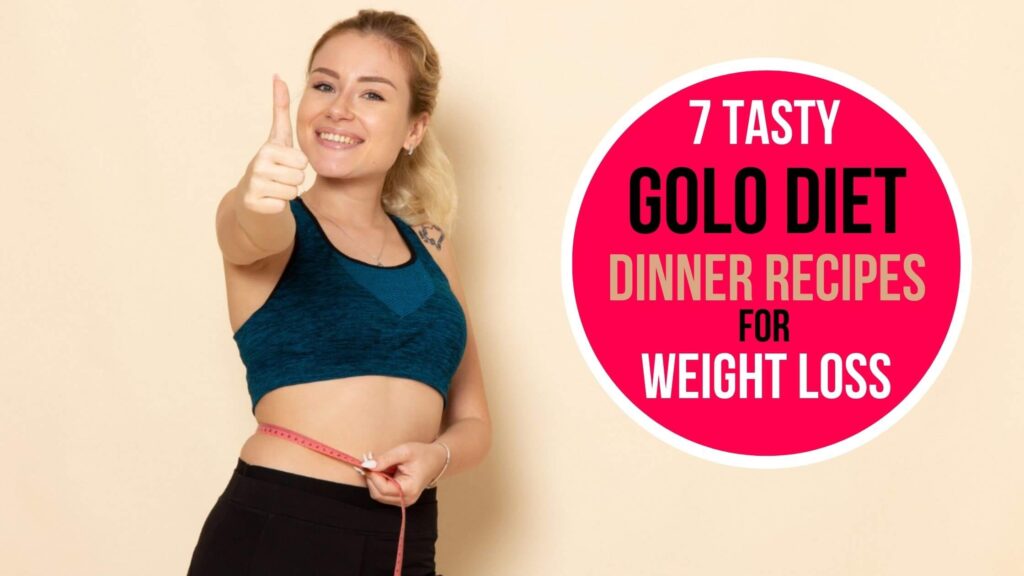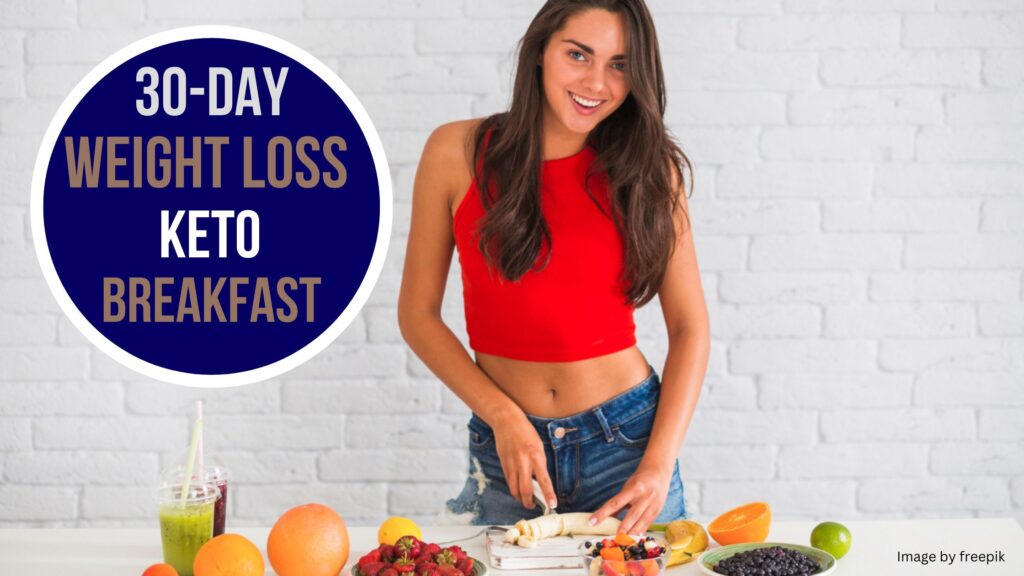7 Easy and Tasty GOLO Diet Dinner Recipes for Weight...
Read More10 Mouthwatering High Protein Diet Dinner Ideas for Optimal Nutrition
Looking to elevate your dinner game with high-protein, nutrition-packed meals? Say no more! Our guide is here to serve up some lip-smacking inspiration for nutritious, High protein diet dinner ideas that are anything but bland.
Table of Contents
ToggleWith our handpicked selection of 10 delectable dinner ideas, you’ll bid farewell to uninspired meals and welcome a world of flavorful, nutrient-dense dishes to your table.
From mouthwatering grilled chicken skewers to savory quinoa-stuffed bell peppers, and more, we’ve got your cravings covered with options that are not only delicious but also power-packed with the protein your body craves.
Whether you’re a fitness enthusiast, a busy parent, or simply someone who appreciates a good, wholesome meal, these recipes are tailored to fit seamlessly into your routine.
Get ready to dust off those cooking skills and dive into a world of high-protein goodness that promises to tantalize your taste buds and fuel your body. It’s time to dine like a pro!
The Importance of High Protein Diet Dinners
In today’s fast-paced world, it’s easy to overlook the importance of a well-balanced dinner. However, incorporating high-protein dinners into your meal plan can have a profound impact on your overall health and well-being.
Protein is an essential macronutrient that plays a crucial role in building and repairing tissues, making enzymes and hormones, and supporting a healthy immune system. By prioritizing high-protein dinners, you can ensure that your body receives the necessary nutrients to thrive and perform at its best.
Consuming high-protein dinners can also aid in weight management by promoting feelings of fullness and reducing overall calorie intake.
Moreover, protein-rich meals can help stabilize blood sugar levels, making them an excellent choice for individuals with diabetes or those looking to prevent blood sugar spikes.
Additionally, high protein dinners are especially beneficial for individuals who lead active lifestyles or engage in regular exercise, as they support muscle recovery and growth.
By understanding the significance of high protein dinners, you can take a proactive approach to optimizing your nutrition and overall health.
Health Benefits of Incorporating High Protein Meals
The benefits of incorporating high-protein meals into your dinner routine extend far beyond muscle building and repair. Protein is a fundamental component of every cell in the body, making it essential for maintaining healthy skin, hair, and nails.
Additionally, a diet rich in protein can contribute to improved bone health, as it aids in the absorption of essential minerals such as calcium and magnesium. Furthermore, high-protein dinners can support cardiovascular health by helping to regulate blood pressure and cholesterol levels.
Research has also shown that consuming adequate protein can assist in the preservation of lean body mass during weight loss, ensuring that the weight loss comes from fat stores rather than muscle tissue.
Moreover, protein has a thermic effect on the body, meaning that it requires more energy to digest, absorb, and metabolize compared to fats and carbohydrates. This can slightly boost the body’s metabolic rate, potentially aiding in weight management.
With a myriad of health benefits associated with high-protein meals, it’s evident that prioritizing protein at dinner time is a valuable investment in your overall well-being.
High Protein Dinner Statistics
The significance of high-protein dinners is underscored by compelling statistics that highlight the impact of protein consumption on health and nutrition.
According to a study published in the “American Journal of Clinical Nutrition,” increasing protein intake can lead to improvements in body composition, weight management, and overall metabolic health.
The research demonstrated that higher protein diets are associated with greater satiety, reduced caloric intake, and enhanced preservation of lean body mass, making them a valuable strategy for individuals aiming to optimize their nutritional intake.
Furthermore, data from the National Health and Nutrition Examination Survey (NHANES) revealed that protein intake among adults in the United States often falls below recommended levels.
This underscores the importance of raising awareness about the benefits of high-protein dinners and providing accessible resources to help individuals incorporate protein-rich meals into their daily routines.
By understanding the compelling statistics related to high-protein dinners, individuals can make informed choices to prioritize protein as a cornerstone of their dinner meals.
Understanding Macronutrients for Dinner
When crafting high-protein dinners, it’s essential to consider the role of macronutrients in achieving a well-balanced meal. In addition to protein, dinner meals should incorporate healthy fats, complex carbohydrates, and a variety of micronutrients to support overall health and vitality.
By understanding the role of macronutrients, you can create dinners that not only satisfy your taste buds but also provide a comprehensive array of nutrients to fuel your body.
Protein serves as the building block for muscle, bone, skin, and other tissues, making it an indispensable component of high-protein dinners. Healthy fats, such as those found in avocados, nuts, and olive oil, play a crucial role in supporting brain function, hormone production, and the absorption of fat-soluble vitamins.
Complex carbohydrates, derived from sources like whole grains, legumes, and vegetables, provide sustained energy and essential fiber for digestive health. By incorporating a balance of macronutrients into your high-protein dinners, you can create meals that nourish your body and contribute to overall well-being.
10 Mouthwatering High Protein Diet Dinner Ideas
1. Grilled Chicken Skewers with Mediterranean Quinoa Salad: Tender, marinated chicken skewers paired with a refreshing quinoa salad packed with vibrant Mediterranean flavors.
2. Salmon with Roasted Vegetables and Herbed Quinoa: Succulent roasted salmon served alongside a colorful array of seasonal vegetables and aromatic herbed quinoa.
3. Turkey and Black Bean Chili: Hearty and flavorful chili made with lean ground turkey, black beans, and a medley of spices, perfect for a cozy evening meal.
4. Grilled Lemon Herb Shrimp with Zucchini Noodles: Luscious grilled shrimp seasoned with bright lemon and fragrant herbs, served over delicate zucchini noodles for a light and refreshing dinner.
5. Greek Turkey Meatballs with Tzatziki Sauce and Greek Salad: Juicy turkey meatballs infused with Mediterranean spices, accompanied by a tangy tzatziki sauce and a vibrant Greek salad.
6. Chickpea and Vegetable Curry with Cauliflower Rice: Aromatic chickpea and vegetable curry served alongside fluffy cauliflower rice, offering a satisfying and nourishing plant-based dinner option.
7. Eggplant and Quinoa Parmesan: Crispy breaded eggplant slices layered with hearty quinoa, savory marinara sauce, and a golden crust of melted mozzarella, creating a satisfying vegetarian spin on a classic Italian dish.
8. Quinoa and Black Bean Stuffed Sweet Potatoes: Wholesome sweet potatoes generously filled with a zesty quinoa and black bean mixture, topped with fresh herbs and a dollop of creamy avocado.
9. Lentil and Spinach Stuffed Bell Peppers: Nutrient-dense bell peppers filled with a savory mix of lentils, spinach, and aromatic spices, baked to perfection.
10. Tofu Stir-Fry with Broccoli and Cashews: Satisfying tofu stir-fry featuring crisp broccoli florets and crunchy cashews, infused with a delectable blend of Asian-inspired flavors.
10 Quick and Easy High Protein Diet Dinner Recipes
Incorporating high-protein dinners into your weekly meal plan doesn’t have to be daunting. With a selection of quick and easy recipes at your fingertips, you can effortlessly whip up protein-packed meals that cater to your taste preferences and dietary needs. Whether you’re a novice in the kitchen or a seasoned home cook, these fuss-free dinner ideas are sure to become staples in your culinary repertoire.
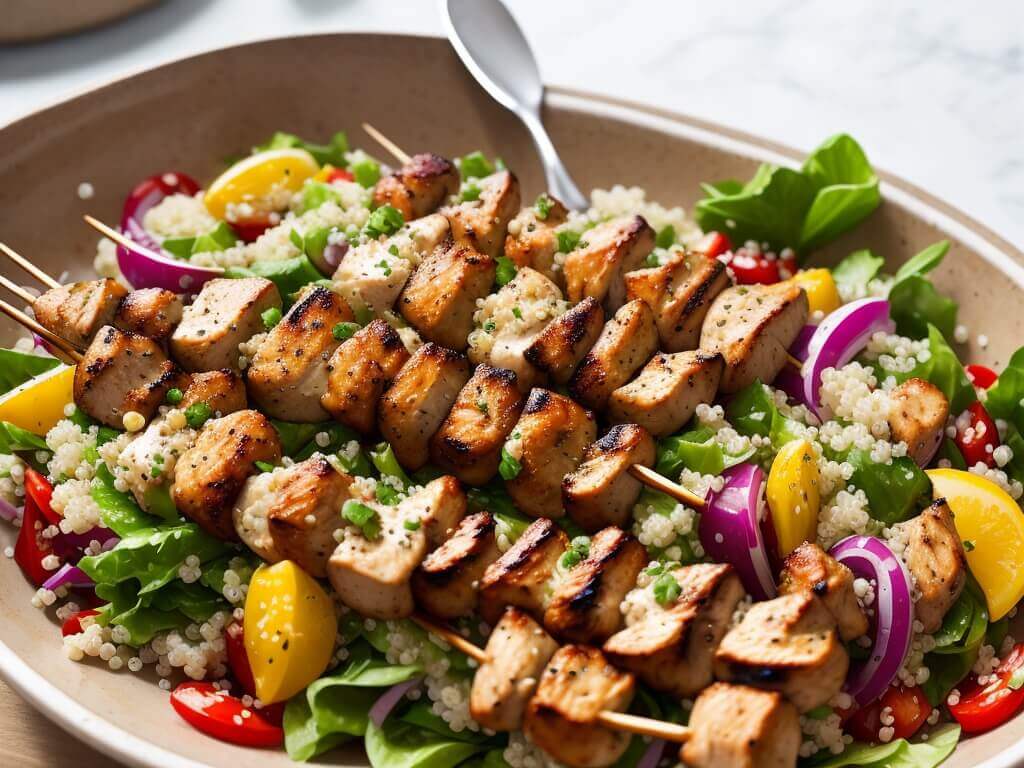
1. Grilled Chicken Skewers with Mediterranean Quinoa Salad
Ingredients:
- 1 lb. boneless, skinless chicken breasts, cut into cubes
- 1 cup quinoa, rinsed
- 1 ½ cups vegetable broth
- 1 cucumber, diced
- 1 pint cherry tomatoes, halved
- ½ red onion, finely chopped
- ¼ cup Kalamata olives, pitted and sliced
- 3 tbsp fresh parsley, chopped
- 3 tbsp fresh mint, chopped
- 1 lemon, juiced
- 3 tbsp extra virgin olive oil
- Salt and pepper to taste
How to prepare
- Preheat the grill to medium-high heat.
- Thread the chicken cubes onto skewers and season with salt and pepper.
- Grill the skewers for 5-7 minutes per side, or until the chicken is cooked through and has a golden char.
- In a medium saucepan, bring the vegetable broth to a boil. Add the quinoa, reduce heat to low, cover, and simmer for 15-20 minutes, or until the quinoa is tender and the liquid is absorbed.
- In a large bowl, combine the cooked quinoa, cucumber, cherry tomatoes, red onion, Kalamata olives, parsley, mint, lemon juice, and olive oil. Toss to mix well and season with salt and pepper to taste.
- Serve the grilled chicken skewers alongside the Mediterranean quinoa salad and enjoy a protein-packed, satisfying meal.
Grilled chicken skewers with Mediterranean quinoa salad are high in protein and low in fat. Chicken is a lean source of protein, with about 26 grams of protein per 3-ounce serving. Quinoa is a complete protein, meaning it contains all nine essential amino acids that your body cannot produce on its own.
It also contains iron, magnesium, and manganese. Quinoa is a good source of fiber, with about 5 grams of fiber per 1 cup of cooked quinoa. Cucumbers, cherry tomatoes, red onion, and Kalamata olives are also high in fiber, with about 2 to 3 grams of fiber per 1 cup of raw vegetables. Fiber can also help you feel full and satisfied, which can prevent overeating and aid in weight management.
It is also packed with antioxidants, Parsley, mint, lemon juice, and olive oil are all good sources of antioxidants, with varying amounts of vitamin C, vitamin A, vitamin E, and phytochemicals.
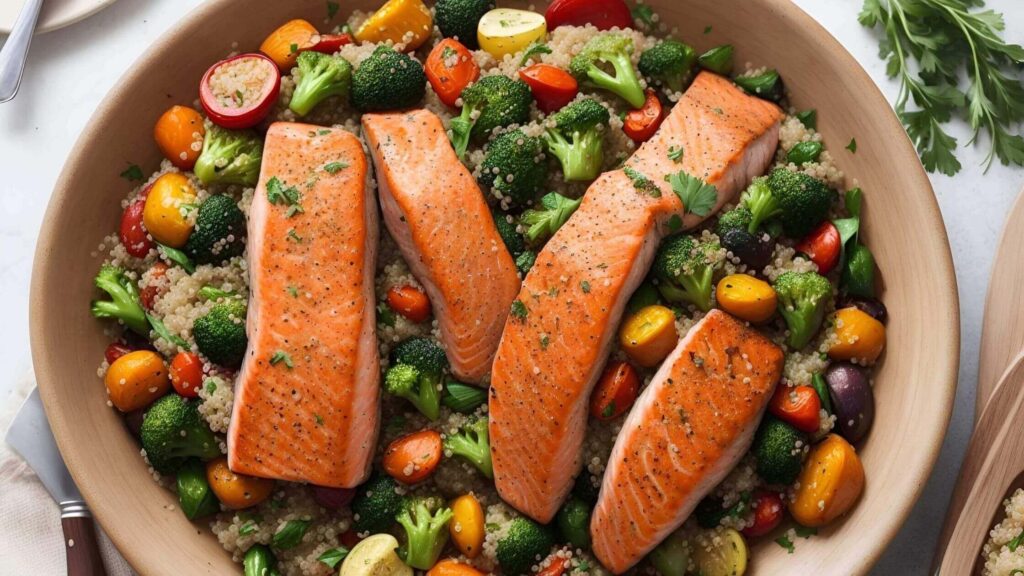
2. Salmon with Roasted Vegetables and Herbed Quinoa
Ingredients:
- 4 salmon fillets
- 2 cups mixed vegetables (bell peppers, zucchini, cherry tomatoes)
- 1 cup quinoa, rinsed
- 2 cups vegetable broth
- 2 tbsp fresh dill, chopped
- 2 tbsp fresh parsley, chopped
- 1 lemon, sliced
- 3 tbsp olive oil
- Salt and pepper to taste.
How to Prepare
- Preheat oven to 400°F.
- Place the salmon fillets on a baking sheet lined with parchment paper. Arrange the mixed vegetables around the salmon and drizzle with 2 tablespoons of olive oil. Season with salt and pepper.
- Place lemon slices on top of the salmon fillets and sprinkle with fresh dill.
- Roast in the oven for 12-15 minutes, or until the salmon is cooked through and the vegetables are tender.
- In a medium saucepan, bring the vegetable broth to a boil. Add the quinoa, reduce heat to low, cover, and simmer for 15-20 minutes, or until the quinoa is fluffy and the liquid is absorbed.
- Fluff the quinoa with a fork and stir in the chopped parsley. Serve the roasted salmon and vegetables over a bed of herbed quinoa for a delightful high-protein dinner option.
Salmon with roasted vegetables and herbed quinoa is high in protein and omega-3 fatty acids. Salmon is a rich source of protein, with about 22 grams of protein per 3-ounce serving. Omega-3 fatty acids are beneficial for your brain, heart, and skin health. Salmon is one of the best sources of omega-3 fatty acids, with about 1.5 grams of omega-3 per 3-ounce serving.
It is also a good source of fiber, Quinoa is a good source of fiber, with about 5 grams of fiber per 1 cup of cooked quinoa. Bell peppers, zucchini, cherry tomatoes, and lemon are also high in fiber, with about 2 to 3 grams of fiber per 1 cup of raw vegetables.
Parsley, dill, garlic, and olive oil are all good sources of antioxidants, with varying amounts of vitamin C, vitamin A, vitamin E, and phytochemicals. Antioxidants boost your immune system and prevent or reduce the risk of chronic diseases.
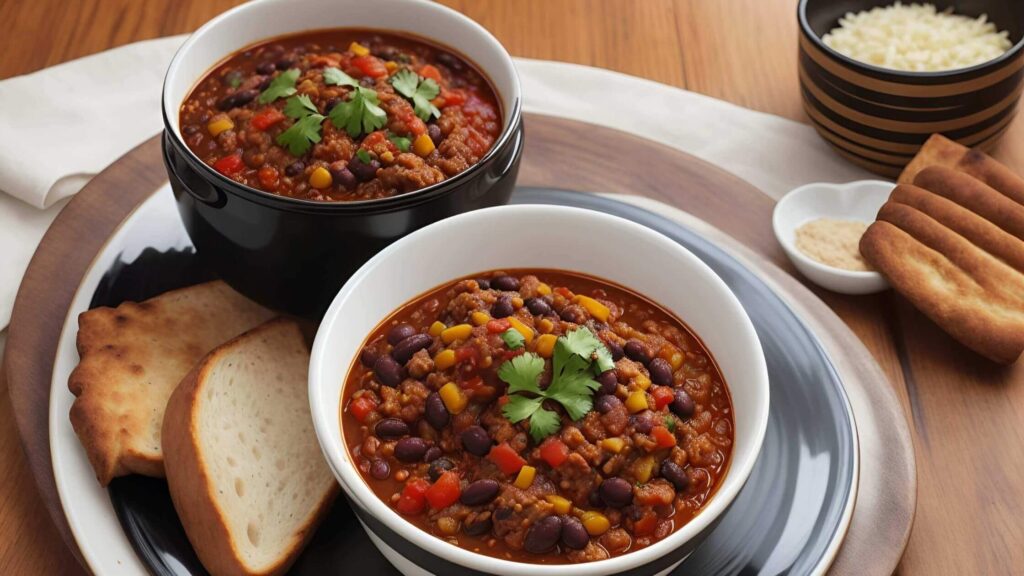
3. Turkey and Black Bean Chili
Ingredients:
- 1 tbsp of olive oil
- 1 lb of lean ground turkey
- 1 large onion, diced
- 4 garlic cloves, finely chopped
- 2 tbsp of chili powder
- 1 tsp of cumin
- 1/2 tsp of salt
- 1/4 tsp of black pepper
- 1 can (15 oz) of black beans, drained and rinsed
- 1 can (14.5 oz) of diced tomatoes, with their juice
- 1 can (8 oz) of tomato sauce
- 1 cup of chicken broth
- Optional toppings: shredded cheese, sour cream, cilantro, green onions, etc.
How to prepare
- In a large skillet, heat the olive oil over medium-high heat. Add the ground turkey and cook, stirring and breaking it up, until browned and cooked through, about 15 minutes. Transfer the turkey to a plate and keep warm.
- In the same skillet, cook the onion and garlic over medium heat, stirring occasionally, until soft, about 10 minutes.
- Stir in the chili powder, cumin, salt, and pepper, and cook for 1 minute.
- Transfer the onion mixture to a 4-quart slow cooker. Add the black beans, diced tomatoes, tomato sauce, and chicken broth and mix well. Add the cooked turkey and stir to combine.
- Cover and cook on low for 6 to 8 hours or on high for 3 to 4 hours, until the chili is thick and flavorful.
- Serve the chili hot, with your preferred toppings if desired.
Turkey and black bean chili is a delicious and nutritious dish that is also low in fat and high in protein. Lean ground turkey has about 22 grams of protein per 3-ounce serving, while black beans have about 8 grams of protein per 1/2 cup serving. It is a good source of fiber, with about 7.5 grams of fiber per 1/2 cup serving. Fiber can also help you feel full and satisfied, which can prevent overeating and aid in weight management.
Tomatoes, garlic, onion, and chili powder are all good sources of antioxidants, which can protect your cells from damage caused by free radicals and inflammation.
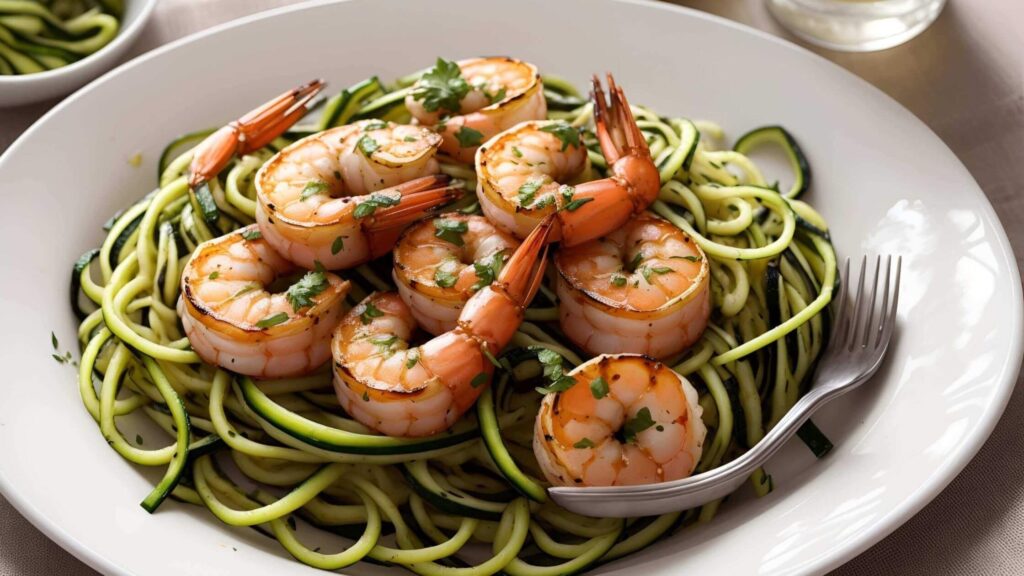
4. Grilled Lemon Herb Shrimp with Zucchini Noodles
Ingredients:
- 1/4 cup of olive oil
- 1/4 cup of lemon juice
- 2 tablespoons of chopped fresh parsley
- 2 tablespoons of chopped fresh dill
- 2 teaspoons of minced garlic
- Salt and pepper, to taste
- 1 pound of large shrimp, peeled and deveined
- 4 medium zucchini, spiralized or cut into thin noodles
- 2 tablespoons of butter
- Optional garnishes: lemon wedges, more herbs, red pepper flakes, etc.
How to prepare
- In a small bowl, whisk together the olive oil, lemon juice, parsley, dill, garlic, salt, and pepper. Reserve 2 tablespoons of the marinade for later use.
- Pour the rest of the marinade into a large ziplock bag and add the shrimp. Seal the bag and toss to coat the shrimp. Refrigerate for 15 to 30 minutes, or up to 2 hours.
- Preheat a grill or a grill pan to medium-high heat. Thread the shrimp onto skewers and discard the marinade.
- Grill the shrimp for 3 to 4 minutes per side, or until pink and opaque.
- In a large skillet, melt the butter over medium-high heat. Add the zucchini noodles and the reserved marinade and toss to combine.
- Cook for 5 to 10 minutes, or until the zucchini noodles are tender but still crisp.
- Serve the grilled shrimp over the zucchini noodles, with your desired garnishes if desired.
Grilled lemon herb shrimp with zucchini noodles are high in protein and vitamin C, which can help you build and repair muscle, as well as boost your immune system and skin health. Shrimp is a lean source of protein, with about 24 grams of protein per 3-ounce serving.
This dish is also a good source of fiber, low-carb, and gluten-free. Fiber can help lower cholesterol, regulate blood sugar, and promote digestive health and it is suitable for people who follow a keto, paleo, or gluten-free diet, as well as those who want to reduce their intake of refined carbohydrates and sugars.
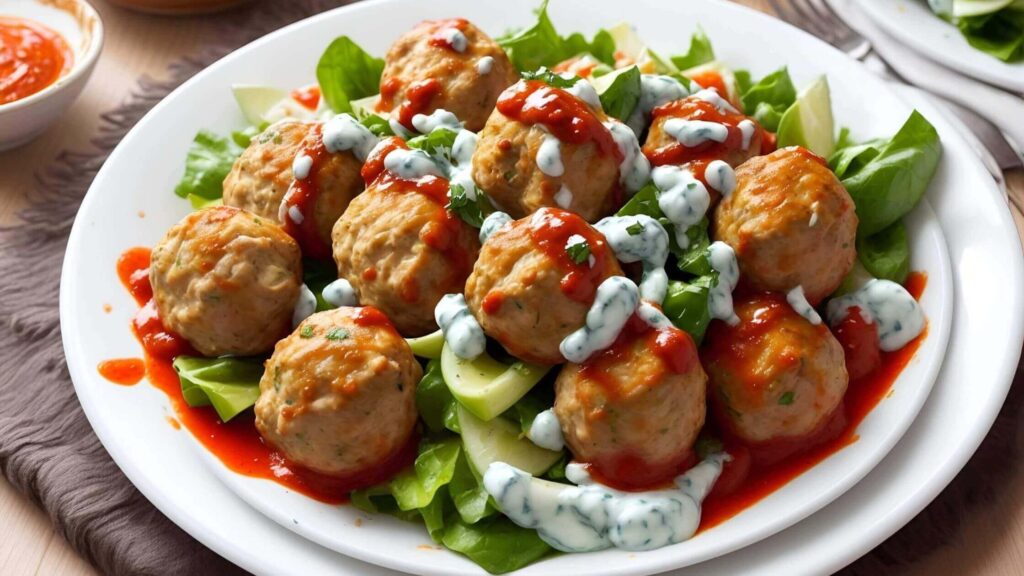
5. Greek Turkey Meatballs with Tzatziki Sauce and Greek Salad
Ingredients:
For the meatballs:
- 1 pound of lean ground turkey
- 1/4 cup of breadcrumbs
- 1/4 cup of crumbled feta cheese
- 2 tablespoons of chopped fresh parsley
- 2 teaspoons of dried oregano
- 1 teaspoon of minced garlic
- 1/2 teaspoon of salt
- 1/4 teaspoon of black pepper
- 1 egg, lightly beaten
- 2 tablespoons of olive oil
For the tzatziki sauce:
- 1 cup of plain Greek yogurt
- 1/4 cup of grated cucumber, squeezed dry
- 2 tablespoons of chopped fresh dill
- 1 tablespoon of lemon juice
- 1/2 teaspoon of minced garlic
- Salt and pepper, to taste
For the Greek salad:
- 4 cups of chopped romaine lettuce
- 2 cups of cherry tomatoes, halved
- 1 cup of sliced cucumber
- 1/4 cup of sliced red onion
- 1/4 cup of pitted kalamata olives
- 1/4 cup of crumbled feta cheese
- 2 tablespoons of olive oil
- 2 tablespoons of red wine vinegar
- 1 teaspoon of dried oregano
- Salt and pepper, to taste.
How to prepare
- To make the meatballs, in a large bowl, combine the turkey, breadcrumbs, feta, parsley, oregano, garlic, salt, pepper, and egg.
- Mix well and shape into 16 equal-sized balls.
- In a large skillet, heat the oil over medium-high heat. Add the meatballs and cook, turning occasionally, for 15 to 20 minutes, or until browned and cooked through.
- To make the tzatziki sauce, in a small bowl, whisk together the yogurt, cucumber, dill, lemon juice, garlic, salt, and pepper. Refrigerate until ready to serve.
- To make the Greek salad, in a large bowl, toss the lettuce, tomatoes, cucumber, onion, olives, and feta.
- In a small bowl, whisk together the oil, vinegar, oregano, salt, and pepper. Drizzle over the salad and toss to coat.
- Serve the meatballs with the tzatziki sauce and the Greek salad, with more lemon wedges if desired.
Greek turkey meatballs with tzatziki sauce and Greek salad are high in protein and calcium, Turkey is a lean source of protein, with about 22 grams of protein per 3-ounce serving. Feta cheese and Greek yogurt are good sources of calcium, with about 140 milligrams of calcium per 1/4 cup of cheese and 100 milligrams of calcium per 1/2 cup of yogurt.
It is also low-carb and gluten-free. Romaine lettuce, cherry tomatoes, cucumber, onion, and olives are all rich in fiber, with about 2 to 3 grams of fiber per 1 cup of raw vegetables.
Vegetarian and Vegan High Protein Diet Dinner Options
For individuals following a vegetarian or vegan lifestyle, there are abundant options to enjoy high-protein dinners that are both satisfying and nourishing.
From plant-based protein sources such as legumes, tofu, tempeh, and quinoa to a vibrant array of vegetables and whole grains, vegetarian and vegan high-protein dinners offer a diverse and delicious approach to meeting your nutritional needs.
Embrace the culinary versatility of vegetarian and vegan ingredients as you explore the following high-protein dinner ideas, designed to delight your palate and elevate your dining experience.
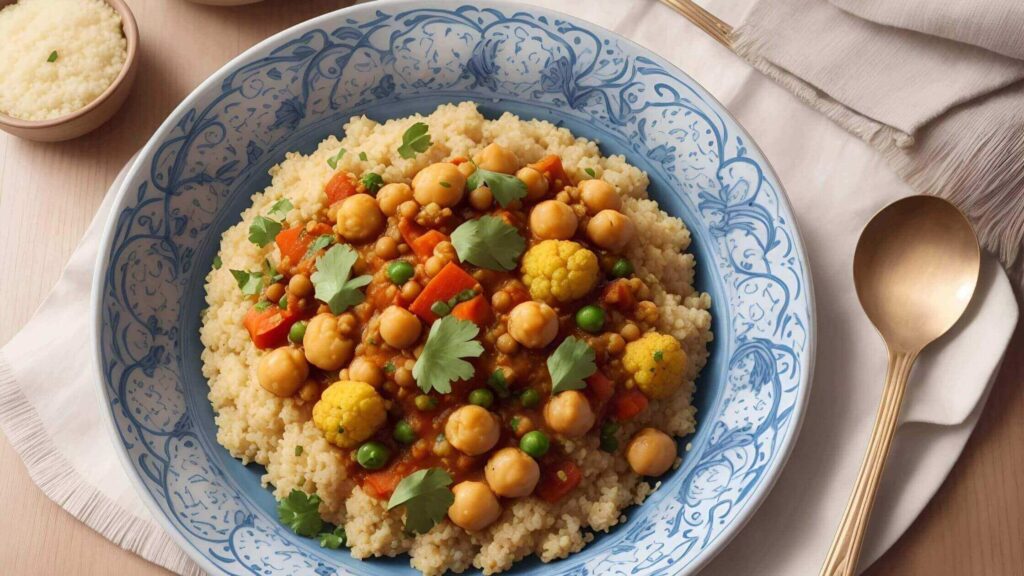
6. Chickpea and Vegetable Curry with Cauliflower Rice
Ingredients:
- 1/4 cup of vegetable oil
- 1 onion, chopped
- 4 garlic cloves, minced
- 1 tablespoon of grated ginger
- 2 teaspoons of curry powder
- 1 teaspoon of turmeric
- 1 teaspoon of salt
- 1/4 teaspoon of cayenne pepper
- 1 (15-ounce) can of chickpeas, drained and rinsed
- 1 (14.5-ounce) can of diced tomatoes, with juice
- 1 cup of vegetable broth
- 2 cups of chopped cauliflower
- 2 cups of chopped carrots
- 2 cups of chopped green beans
- 1/4 cup of chopped fresh cilantro
- 1 large head of cauliflower, cut into florets
- 2 tablespoons of butter
- Salt and pepper, to taste.
How to prepare
- In a large skillet, heat the oil over medium-high heat. Add the onion, garlic, ginger, curry powder, turmeric, salt, and cayenne pepper and cook, stirring frequently, for 15 to 20 minutes, or until the onion is soft and golden.
- Add the chickpeas, tomatoes, and broth, and bring to a boil. Reduce the heat and simmer, uncovered, for 10 minutes, or until slightly thickened.
- Add the cauliflower, carrots, and green beans and simmer, covered, for 15 to 20 minutes, or until the vegetables are tender.
- Stir in the cilantro and taste for seasoning. Adjust as needed.
- In a food processor, pulse the cauliflower florets until they resemble rice. Transfer to a microwave-safe bowl and microwave for 5 to 10 minutes, or until cooked and fluffy.
- Fluff with a fork and stir in the butter, salt, and pepper.
- Serve the chickpea and vegetable curry over the cauliflower rice, with more cilantro if desired.
Chickpea and vegetable curry with cauliflower is protein-rich, with 12 grams of protein per serving from the chickpeas and the cauliflower, and also vegan and gluten-free. It is suitable for people who follow a plant-based, dairy-free, or gluten-free diet, as well as those who want to increase their intake of vegetables and legumes.
With about 12 grams of fiber per 1 cup of cooked chickpeas, this rice is also high in fiber and antioxidants, which can help lower cholesterol, regulate blood sugar, and protect your cells from damage and inflammation.
It is also low in calories and carbohydrates, which can help you maintain a healthy weight and lower your risk of obesity, diabetes, and heart disease.
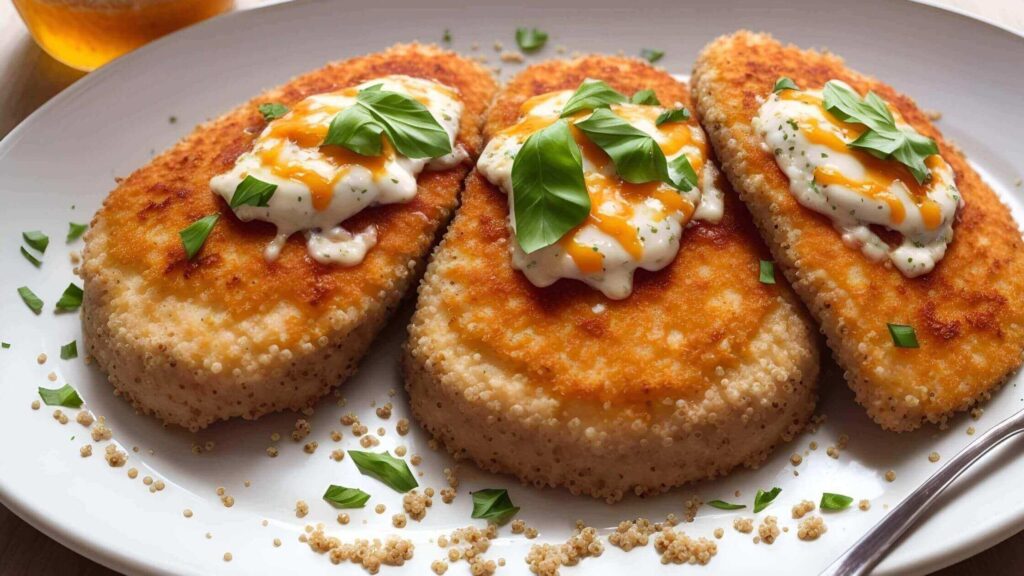
7. Eggplant and Quinoa Parmesan
Ingredients
- 1 large eggplant, sliced into 1/4-inch thick rounds
- Salt, to taste
- 2 eggs, lightly beaten
- 1/2 cup of grated Parmesan cheese
- 1/4 cup of all-purpose flour
- 1/4 teaspoon of black pepper
- 1/4 cup of vegetable oil
- 2 cups of cooked quinoa
- 2 cups of marinara sauce
- 2 cups of shredded mozzarella cheese
- 2 tablespoons of chopped fresh basil
How to prepare
- Preheat the oven to 375°F and spray a 9×13-inch baking dish with cooking spray.
- Sprinkle the eggplant slices with salt and let them sit for 15 minutes to draw out the excess moisture. Pat them dry with paper towels.
- In a shallow bowl, whisk together the eggs and 1/4 cup of Parmesan cheese. In another shallow bowl, whisk together the flour, pepper, and a pinch of salt.
- Dip each eggplant slice in the flour mixture, then in the egg mixture, and then in the flour mixture again, shaking off any excess. Place them on a large plate or baking sheet.
- In a large skillet, heat the oil over medium-high heat. Fry the eggplant slices in batches, for 3 to 4 minutes per side, or until golden and crisp. Drain them on paper towels and keep them warm.
- In a small bowl, toss the quinoa with the remaining 1/4 cup of Parmesan cheese.
- To assemble the dish, spread 1/2 cup of marinara sauce evenly over the bottom of the prepared baking dish. Arrange half of the eggplant slices over the sauce, overlapping slightly. Spoon 1/2 cup of marinara sauce over the eggplant. Sprinkle 1 cup of mozzarella cheese over the sauce. Repeat with the remaining eggplant, sauce, and cheese. Sprinkle the basil over the top.
- Bake for 15 to 20 minutes, or until the cheese is melted and bubbly.
- Serve the eggplant and quinoa parmesan hot, with more basil if desired.
The eggplant and quinoa parmesan dish is protein rich, with 18 grams of protein per serving from the eggplant, quinoa, and cheese and it is also vegetarian and gluten-free. It is suitable for people who follow a plant-based, dairy-free, or gluten-free diet.
This is also high in fiber and antioxidants, which can help lower cholesterol, regulate blood sugar, and protect your cells from damage and inflammation. Eggplant is a good source of fiber, with about 3 grams of fiber per 1 cup of cooked eggplant. It also contains anthocyanins, which are purple pigments that have anti-inflammatory and anti-cancer properties.
Marinara sauce, garlic, onion, and basil are also rich in antioxidants, with varying amounts of vitamin C, vitamin A, vitamin E, and phytochemicals.
Eggplant and quinoa parmesan is also good source of calcium, which can help you build and maintain bone and teeth health. Parmesan cheese and mozzarella cheese are good sources of calcium, with about 200 milligrams of calcium per 1/4 cup of cheese.
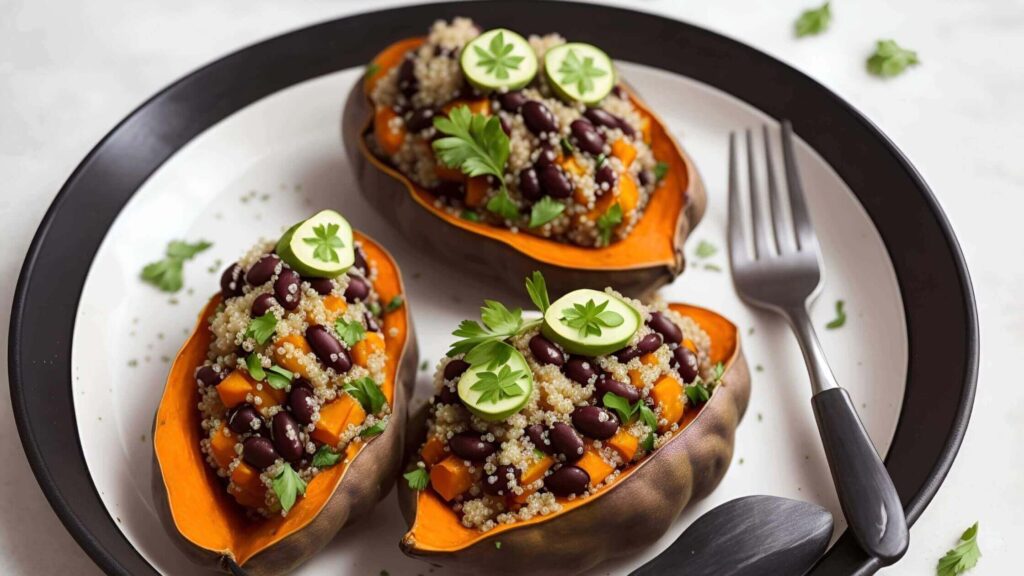
8. Quinoa and Black Bean Stuffed Sweet Potatoes
Ingredients:
- 4 medium sweet potatoes, scrubbed and pierced with a fork
- 1 cup of quinoa, rinsed and drained
- 2 cups of vegetable broth
- 1 tablespoon of olive oil
- 1 onion, diced
- 2 garlic cloves, minced
- 1 (15-ounce) can of black beans, drained and rinsed
- 1/4 cup of chopped fresh cilantro
- 2 teaspoons of lime juice
- Salt and pepper, to taste
- 1 ripe avocado, peeled and mashed
- Optional toppings: salsa, sour cream, cheese, etc.
How to prepare
- Preheat the oven to 400°F and line a baking sheet with parchment paper. Place the sweet potatoes on the prepared baking sheet and bake for 45 to 60 minutes, or until tender.
- In a small saucepan, bring the quinoa and vegetable broth to a boil. Reduce the heat and simmer, covered, for 15 to 20 minutes, or until the quinoa is fluffy and the broth is absorbed.
- In a large skillet, heat the olive oil over medium-high heat. Add the onion and garlic and cook, stirring occasionally, for 10 to 15 minutes, or until soft and golden.
- Add the black beans, cilantro, lime juice, salt, and pepper and cook, stirring, for 5 minutes, or until heated through.
- Cut the sweet potatoes in half and scoop out some of the flesh, leaving a 1/4-inch border.
- Transfer the scooped flesh to a large bowl and mash with a fork. Stir in the quinoa and black bean mixture and mix well.
- Spoon the filling back into the sweet potato shells and return to the oven for 10 minutes, or until warm.
- Serve the stuffed sweet potatoes with a dollop of mashed avocado and your favorite toppings if desired.
Quinoa and black bean stuffed sweet potatoes is a dish that is high in protein and fiber, which can help you feel full and satisfied, as well as support your muscle and digestive health. Also gluten-free and vegetarian. They are suitable for people with celiac disease, wheat allergy, or gluten sensitivity, as well as those who follow a plant-based diet.
Low in fat and calories, which can help you maintain a healthy weight and lower your risk of obesity, diabetes, and heart disease. One serving of this dish (half a stuffed sweet potato) has only about 300 calories and 8 grams of fat while providing 12 grams of protein and 10 grams of fiber.
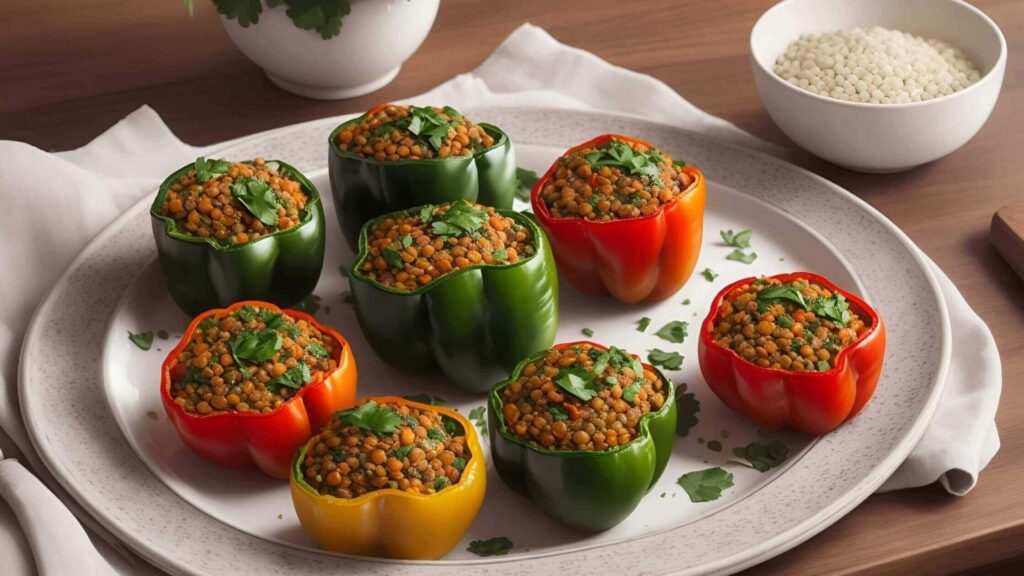
9. Lentil and Spinach Stuffed Bell Peppers
Ingredients:
- 4 bell peppers, halved and seeds removed
- 1 cup green or brown lentils, cooked
- 2 cups baby spinach, chopped
- 1 onion, finely chopped
- 2 cloves garlic, minced
- 1 tsp cumin
- 1 tsp paprika
- ½ tsp chili powder
- 1 cup tomato sauce
- ½ cup vegetable broth
- Salt and pepper to taste.
How to Prepare
- Preheat oven to 375°F.
- In a skillet, sauté the onion and garlic until fragrant and translucent.
- Add the cooked lentils, chopped spinach, cumin, paprika, and chili powder to the skillet. Cook for 5-7 minutes, or until the spinach wilts and the flavors meld together.
- Stir in half of the tomato sauce and vegetable broth. Simmer for an additional 5 minutes, adjusting the seasoning as needed.
- Spoon the lentil and spinach mixture into the halved bell peppers, arranging them in a baking dish.
- Drizzle the remaining tomato sauce over the stuffed peppers and cover the dish with foil. Bake for 25-30 minutes, or until the peppers are tender.
- Serve the lentil and spinach stuffed bell peppers as a wholesome and protein-rich vegetarian dinner option.
Lentil and spinach stuffed bell peppers are high in protein and iron, which can help you build and maintain muscle, as well as support your blood and immune health.
With about 18 grams of protein per 1 cup of cooked lentils and they also contain iron, folate, and manganese. Spinach is also a good source of iron, with about 3 milligrams of iron per 1 cup of cooked spinach. It also contains vitamin A, vitamin C, vitamin K, and calcium. This recipe also a gluten-free.
Bell peppers are rich in fiber, with about 3 grams of fiber per 1 cup of raw bell peppers. They also contain vitamin C, vitamin B6, and antioxidants.
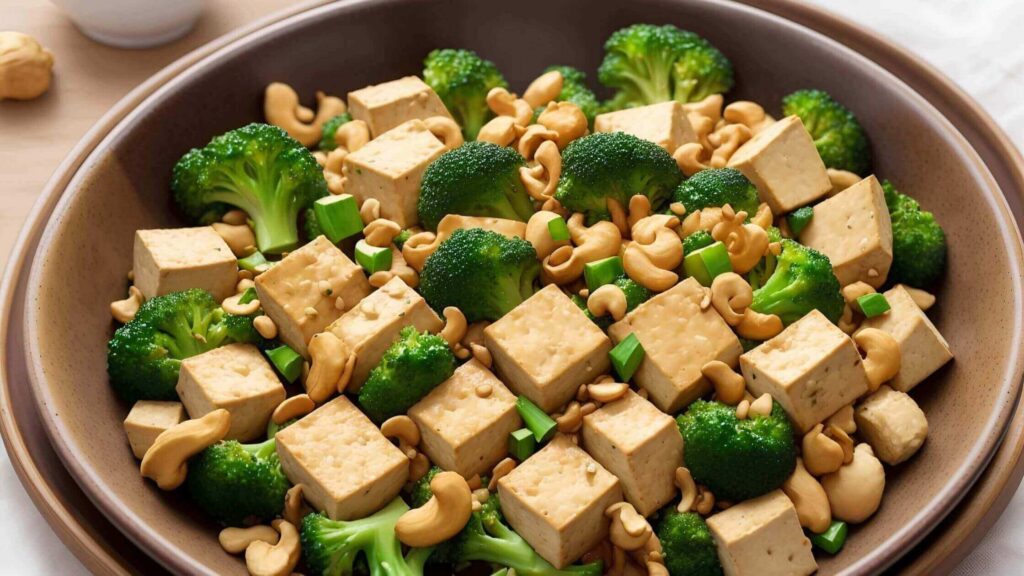
10. Tofu Stir-Fry with Broccoli and Cashews
Ingredients:
- 1 block extra-firm tofu, pressed and cubed
- 3 cups broccoli florets
- 1 bell pepper, sliced
- 1 cup snap peas
- ½ cup cashews
- 3 cloves garlic, minced
- 1-inch piece of ginger, grated
- 3 tbsp soy sauce
- 2 tbsp hoisin sauce
- 1 tbsp sesame oil
- 2 tbsp vegetable oil
- Cooked brown rice or quinoa for serving.
How to Prepare
- In a wok or large skillet, heat the vegetable oil over medium-high heat.
- Add the cubed tofu and cook until golden and crisp on all sides. Remove the tofu from the wok and set aside.
- In the same wok, add the broccoli, bell pepper, snap peas, garlic, and ginger. Stir-fry for 5-7 minutes, or until the vegetables are tender-crisp.
- Return the cooked tofu to the wok and add the soy sauce, hoisin sauce, and sesame oil. Toss to coat the tofu and vegetables evenly.
- Stir in the cashews and cook for an additional 2-3 minutes.
- Serve the tofu stir-fry with broccoli and cashews over a bed of brown rice or quinoa for a delightful vegan high-protein dinner.
Tofu stir-fry with broccoli and cashews is also high in protein and calcium, which can help you build and maintain muscle, as well as support your bone and teeth health.
Tofu is a soy-based product that contains all nine essential amino acids that your body cannot produce on its own. It also contains calcium, iron, and magnesium. Cashews are a good source of protein, providing 5g per 1/4 cup. Additionally, they contain essential minerals such as calcium, magnesium, and zinc.
Broccoli, bell peppers, and snap peas are all fiber-rich vegetables that provide about 2-3 grams of fiber per 1 cup of raw produce. Additionally, they contain vitamin C, vitamin A, vitamin K, and antioxidants. Brown rice and quinoa are high in fiber and complex carbs, providing sustained energy with 3-4g of fiber per cup of cooked grains.
High Protein Dinner Meal Prep Tips
Efficient meal prep is the key to seamlessly incorporating high-protein dinners into your weekly routine. By dedicating a portion of your time to preparing and pre-cooking components of your meals, you can streamline the dinner-making process and ensure that nutritious, protein-rich options are readily available when hunger strikes. Consider the following meal prep tips to set yourself up for success in high-protein dinners.
First and foremost, stocking up on lean protein sources such as chicken breast, turkey, fish, tofu, and legumes is key to building a foundation for your protein-packed meals.
Additionally, incorporating a variety of fresh vegetables, whole grains, and healthy fats will not only enhance the nutritional profile of your dinners but also add an exciting mix of flavors and textures to your plate.
To streamline your meal prep process, consider batch-cooking your protein sources and storing them in portioned containers for easy access throughout the week.
Lastly, don’t underestimate the power of herbs, spices, and marinades to elevate the taste of your high-protein dishes and keep things interesting.
With these meal prep tips in mind, you’re well on your way to creating a lineup of high-protein dinners that will leave you feeling satisfied and fueled for whatever lies ahead.
Dining Out Options for High Protein Dinners
While preparing high-protein dinners at home offers control over ingredients and nutrition, there are times when dining out is inevitable.
The good news is that many restaurants now offer an array of high-protein options that cater to individuals seeking nutritious and satisfying dinner choices. When dining out, consider choosing restaurants that feature grilled or roasted lean protein options such as chicken, turkey, fish, or tofu as the centerpiece of their dishes.
Additionally, don’t hesitate to customize your order by swapping out carb-heavy sides for nutrient-dense options like steamed vegetables, quinoa, or a side salad with a protein topping.
If you’re in the mood for international cuisine, look for restaurants that offer dishes like grilled kebabs, stir-fried lean protein with vegetables, or seafood-based entrees that are rich in protein and flavor.
Lastly, don’t forget to explore the diverse world of plant-based dining options, where innovative chefs are crafting high-protein meals using ingredients like lentils, chickpeas, quinoa, and tempeh to satisfy even the most discerning palates.
By being mindful of your choices and seeking out restaurants that prioritize high-protein offerings, you can enjoy a satisfying dinner out without compromising your nutritional goals.
Wrapping Up High-Protein Diet Dinner Ideas
In conclusion, embracing a high-protein dinner routine not only tantalizes your taste buds but also fuels your body with essential nutrients for optimal health.
These ten mouthwatering recipes offer a delectable journey into the realm of nutritious dining, proving that eating for both pleasure and wellness is not only possible but incredibly satisfying.
Indulge in these delectable, protein-rich dishes that are not only good for you but also a gastronomic delight for those who value nutritious eating.
Bon appétit!
#HighProteinDiet #HighProteinDietDinner #HighProteinDietDinnerIdeas #ProteinDiet #HighProteinDinnerRecipes #ProteinRichMeals #HealthyEating #DinnerIdeas #ProteinPower #CleanEating
Image Credit:
Related Posts:
Jumpstart Your Day with 30-Day Weight Loss Keto Breakfast.
Jumpstart Your Day with 30-Day Weight Loss Keto Diet Breakfast....
Read More

